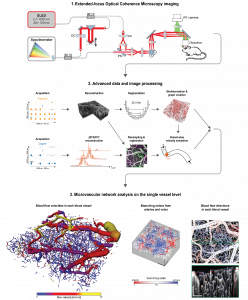New Imaging Technique Reveals Detailed Map of Brain's Blood Flow in 3D
GA, UNITED STATES, November 15, 2024 /EINPresswire.com/ -- Researchers from the University of Zurich and ETH Zurich have developed an advanced optical microscopy technique that enables the study of the brain’s vascular networks in unprecedented detail and on a large scale. Published in Light: Science & Applications, this study showcases the use of Bessel beam optical coherence microscopy to explore the complex three-dimensional brain vessel morphology and flow dynamics, from large arteries down to the smallest capillaries.
Cutting-Edge Imaging and Data Processing for Vascular Network Mapping
The newly developed technique uses a Bessel beam to extend the focus of optical coherence microscopy, allowing for a detailed imaging of large sections of the brain. Unlike traditional methods that either look at tiny volumes or lose detail over larger areas, this approach provides a comprehensive view of the vascular network. By integrating high-sensitivity Doppler optical coherence tomography with advanced data processing algorithms, the researchers can precisely measure blood flow velocities and directions across thousands of brain vessels. This technique ultimately makes it possible to capture the interplay between blood flow, vessel size, and connectivity within the brain's intricate microvascular network.
Significance for Neurovascular Research
Understanding the brain’s vascular network is crucial for studying the brain function and neurological diseases such as Alzheimer’s and stroke. This new imaging method enables researchers to observe changes in blood flow and vessel connectivity over time, providing valuable insights into how these conditions develop and progress. Moreover, by visualizing these changes in an intact living brain, the technique allows for the assessment of how potential treatments impact brain blood flow, thus marking a significant advancement in neurological research.
Looking Ahead
The researchers plan to extend the application of this technology to study a range of neurovascular conditions, starting with the effects of stroke and its potential treatments on the blood flow in affected brain regions. Applications to other organs and diseases are also envisioned, which could significantly facilitate vascular research and development of targeted therapies.
DOI
10.1038/s41377-024-01649-1
Original Source URL
https://doi.org/10.1038/s41377-024-01649-1
Lucy Wang
BioDesign Research
email us here
Legal Disclaimer:
EIN Presswire provides this news content "as is" without warranty of any kind. We do not accept any responsibility or liability for the accuracy, content, images, videos, licenses, completeness, legality, or reliability of the information contained in this article. If you have any complaints or copyright issues related to this article, kindly contact the author above.

